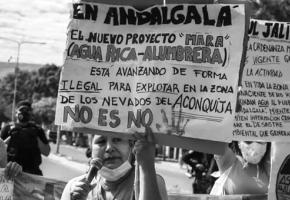2. The Ecuadorian government: friend or foe?
Ecuador is not alone in having viewed its substantial oil resources as a ‘free’ resource to be tapped to provide a source of easy cash to be used for a wide range of purposes, whether socially useful (education, health and public transport), arguably wasteful (vanity construction projects), militaristic (arms purchases and territorial expansion) or simply corrupt (the enrichment of ministers, political parties and élites). Peru, Chile, Bolivia, Brazil, Venezuela, Mexico – most of the countries of the region have succumbed to the temptation of extractivism, under governments of the right, centre and left.
Invariably their own capital and technological resources have not been adequate to the task and the solution has been to turn to the vast oil and mining companies (mostly US, Canadian or European, and latterly also Chinese) with the cash, skilled staff and equipment to do the job.
Like other developing countries who find themselves with the ‘gift’ or ‘curse’ of natural resources, Ecuador was under pressure from the International Monetary Fund (IMF) to exploit its oil reserves. By the year 2000, foreign debt had reached US$15 billion, and the country required an IMF loan of US$300 million. This was a prerequisite for a further US$1.7 billion from the World Bank and InterAmerican Development Bank. The IMF loan, in turn, was conditional on fulfilling the requirements of the International Financial Institutions which included allowing foreign companies to build and operate pipelines. Ecuador caved in.


Map of OCP pipeline. Image: OCPEcuador website
This meant opening up the rainforest for oil exploration and drilling. Since 2000, the Ecuadorian government has auctioned off concessions over the entire Ecuadorian Amazon basin to foreign oil companies. By 2005, seven oil companies were operating in the area: the Oleoducto de Crudo Pesado (OCP) pipeline was built to transport oil from the rainforest to the coast, as well as a road through the Yasuní national park. Oil drilling and its associated infrastructure result in deforestation, the disappearance of entire indigenous communities, and reduction of the mammalian population1.

Oleoducto de Crudo Pesado, Amazonas terminal, Lago Agrio. Photo: OCPEcuador
The crucial questions concern the terms on which are these foreign companies engaged. At what price will exploration rights and concessions to extract be sold? What infrastructure gain (roads, railways, ports) will be stipulated? Will training and employment of nationals and locals be required? Are social dividends (schools, health clinics) to be exacted? How will environmental and other damage be avoided or mitigated? Will the land be restored to its former condition? And what taxes and royalties will be levied?
All too often, the process of negotiation between government and company is profoundly unequal. The companies typically have vastly greater technical knowledge and legal expertise than the government ministries with whom they must reach agreement. And, once agreement is reached, governments lack the resources, and sometimes the will, to inspect, investigate and enforce.
Failure to enforce
Ecuador was no exception. The government had anticipated the possibility of contamination before Texaco began their operations: in 1971, it passed the Hydrocarbon Law, Decree 1459, ‘requiring oil producers to adopt all necessary measures for the protection of the flora and fauna and other natural resources, and to prevent the pollution of water, the atmosphere and the land’ (according to the Chevron website, no date). The company was required to follow environmental guidelines, but it appears that the government failed to enforce them.
The Ecuadorian government’s responsibility was not confined to regulation. Through the state oil company CEPE (now called PetroEcuador) it acquired first a 25% and later a majority stake in the Texaco-Gulf consortium that was drilling and extracting oil in Rio Agrio. However, while the government initially had a 67.5 per cent in the consortium, the management of that operation was carried out entirely by Texaco, which was thus responsible for decisions about operational methods and environment protection on the ground. It would appear that the state-owned oil enterprise PetroEcuador continued where Texaco left off without making substantial changes. Arguably, they inherited a flawed production system from Texaco.
Moreover, the Ecuadorian government indemnified Texaco against claims for damage caused by their operations: a Memorandum of Understanding to that effect was agreed in 1994 between PetroEcuador and the government of Ecuador represented by the Minister of Energy and Mines, Gustavo Galindo Velasco, setting out the scope of remediation work required of Texpet (Texaco´s Ecuadorian operation). Work was carried out with the approval of Ecuadorian inspectors, amounting to US$40 million for ‘remediation, infrastructure improvements, and socioeconomic contributions’, according to Chevron. On 30 September 1998, the Ecuadorian government (represented by its Minister of Energy and Mines), PetroEcuador, PetroProduccion and TexPet signed the ‘Acta Final’, certifying that TexPet had performed all its obligations under the 1995 Settlement Agreement and releasing TexPet from any environmental liability arising from the Consortium’s operations.
Cosmetic remediation
The ‘remedial work’ undertaken by the company, however, was ‘extremely limited in scope and largely cosmetic’, according to Professor Kimerling2. ‘Contaminated liquids were dumped into waterways without sampling or treatment; pits containing high levels of petroleum were backfilled without removing or treating the oil; and some of the oil and contaminated soils and vegetation that were removed were burned in open fires, dumped in nearby forests, or buried in unlined holes in the ground’.
Ecuadorian President Rafael Correa, who was elected in 2006, supported the ongoing lawsuit against Chevron, by now the owner of Texaco and arguably inheritor of its responsibilities, and was ‘basically calling for the heads of government officials that signed off the remediation’, according to Steve Donziger, the US lawyer acting for the plaintiffs, about whom we will hear more in the third article. In a further irony, Correa would be accused by his successor, Lenín Moreno, of using US$10 million of public funds to support indigenous people and settlers in Amazonia in their case against Chevron. One might wonder what other funds is the head of state supposed to use to defend his country and its communities?
Somehow, everyone and no one was responsible for the oil spills. As we shall see in the third article in this series, the moral case did not correspond with the legal case, which was complicated by questions of who was filing lawsuits on behalf of whom, and details with regard to jurisdiction, national and international law, and precedent.
Linda Etchart is a lecturer in Human Geography at Kingston University. She is author of the chapter ‘Indigenous Peoples and the Rights of Nature’ in LAB’s new book Voices of Latin America (forthcoming, Jan 2019).
This article was first published on www.lab.org,uk where you'll find plenty more great articles on Latin American issues

















